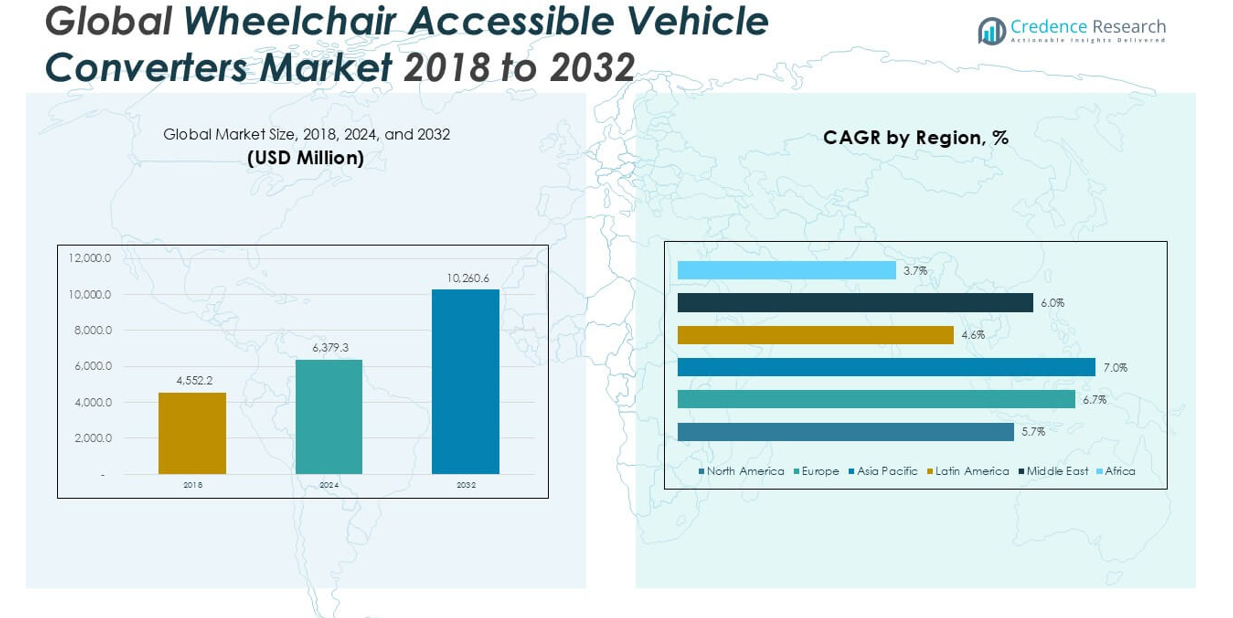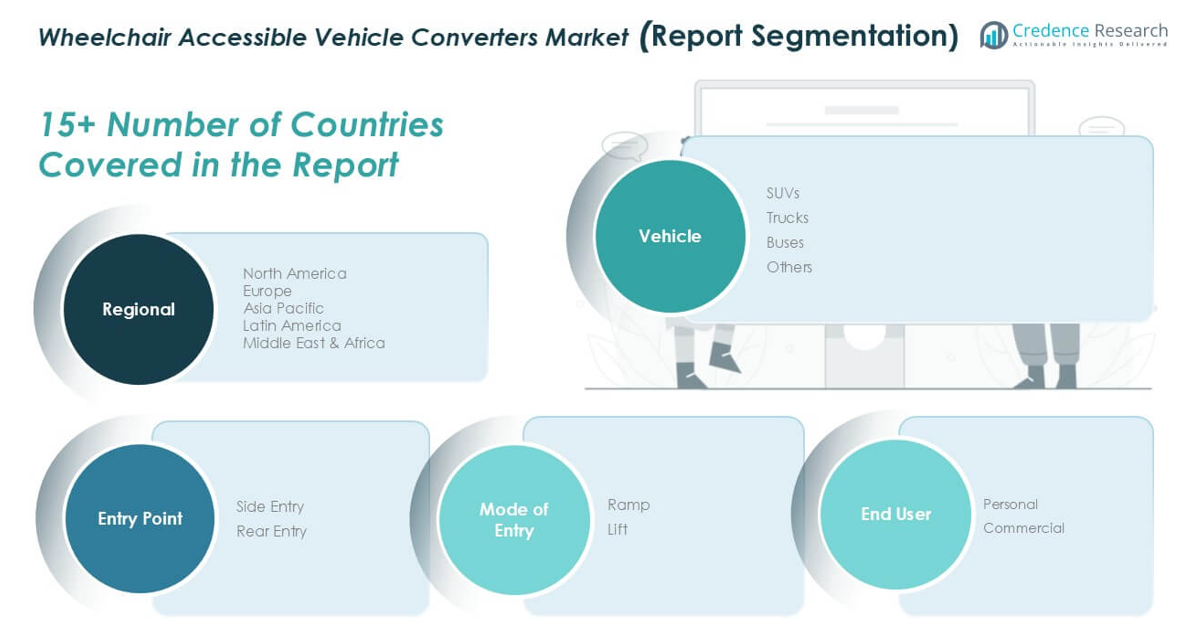CHAPTER NO. 1 : GENESIS OF THE MARKET
1.1 Market Prelude – Introduction & Scope
1.2 The Big Picture – Objectives & Vision
1.3 Strategic Edge – Unique Value Proposition
1.4 Stakeholder Compass – Key Beneficiaries
CHAPTER NO. 2 : EXECUTIVE LENS
2.1 Pulse of the Industry – Market Snapshot
2.2 Growth Arc – Revenue Projections (USD Million)
2.3. Premium Insights – Based on Primary Interviews
CHAPTER NO. 3 : WHEELCHAIR ACCESSIBLE VEHICLE CONVERTERS MARKET FORCES & INDUSTRY PULSE
3.1 Foundations of Change – Market Overview
3.2 Catalysts of Expansion – Key Market Drivers
3.2.1 Momentum Boosters – Growth Triggers
3.2.2 Innovation Fuel – Disruptive Technologies
3.3 Headwinds & Crosswinds – Market Restraints
3.3.1 Regulatory Tides – Compliance Challenges
3.3.2 Economic Frictions – Inflationary Pressures
3.4 Untapped Horizons – Growth Potential & Opportunities
3.5 Strategic Navigation – Industry Frameworks
3.5.1 Market Equilibrium – Porter’s Five Forces
3.5.2 Ecosystem Dynamics – Value Chain Analysis
3.5.3 Macro Forces – PESTEL Breakdow
CHAPTER NO. 4 : KEY INVESTMENT EPICENTER
4.1 Regional Goldmines – High-Growth Geographies
4.2 Product Frontiers – Lucrative Product Categories
4.3 End User Sweet Spots – Emerging Demand Segments
CHAPTER NO. 5: REVENUE TRAJECTORY & WEALTH MAPPING
5.1 Momentum Metrics – Forecast & Growth Curves
5.2 Regional Revenue Footprint – Market Share Insights
5.3 Segmental Wealth Flow – Product, Entry Point, Mode of Entry, & End User Revenue
CHAPTER NO. 6 : TRADE & COMMERCE ANALYSIS
6.1. Import Analysis By Region
6.1.1. Global Wheelchair Accessible Vehicle Converters Market Import Revenue By Region
6.2. Export Analysis By Region
6.2.1. Global Wheelchair Accessible Vehicle Converters Market Export Revenue By Region
CHAPTER NO. 7 : COMPETITION ANALYSIS
7.1. Company Market Share Analysis
7.1.1. Global Wheelchair Accessible Vehicle Converters Market: Company Market Share
7.2. Global Wheelchair Accessible Vehicle Converters Market Company Revenue Market Share
7.3. Strategic Developments
7.3.1. Acquisitions & Mergers
7.3.2. New Product Launch
7.3.3. Regional Expansion
7.4. Competitive Dashboard
7.5. Company Assessment Metrics, 2024
CHAPTER NO. 8 : WHEELCHAIR ACCESSIBLE VEHICLE CONVERTERS MARKET – BY PRODUCT SEGMENT ANALYSIS
8.1. Wheelchair Accessible Vehicle Converters Market Overview By Product Segment
8.1.1. Wheelchair Accessible Vehicle Converters Market Revenue Share By Product
8.2. SUVs
8.3. Trucks
8.4. Buses
8.5. Others
CHAPTER NO. 9 : WHEELCHAIR ACCESSIBLE VEHICLE CONVERTERS MARKET – BY ENTRY POINT SEGMENT ANALYSIS
9.1. Wheelchair Accessible Vehicle Converters Market Overview By Entry Point Segment
9.1.1. Wheelchair Accessible Vehicle Converters Market Revenue Share By Entry Point
9.2. Side Entry
9.3. Rear Entry
CHAPTER NO. 10 : WHEELCHAIR ACCESSIBLE VEHICLE CONVERTERS MARKET – BY MODE OF ENTRY SEGMENT ANALYSIS
10.1. Wheelchair Accessible Vehicle Converters Market Overview By Mode of Entry Segment
10.1.1. Wheelchair Accessible Vehicle Converters Market Revenue Share By Mode of Entry
10.2. Ramp
10.3. Lift
CHAPTER NO. 11 : WHEELCHAIR ACCESSIBLE VEHICLE CONVERTERS MARKET – BY END USER SEGMENT ANALYSIS
11.1. Wheelchair Accessible Vehicle Converters Market Overview By End User Segment
11.1.1. Wheelchair Accessible Vehicle Converters Market Revenue Share By End User
11.2. Personal
11.3. Commercial
CHAPTER NO. 12 : WHEELCHAIR ACCESSIBLE VEHICLE CONVERTERS MARKET – REGIONAL ANALYSIS
12.1. Wheelchair Accessible Vehicle Converters Market Overview By Region Segment
12.1.1. Global Wheelchair Accessible Vehicle Converters Market Revenue Share By Region
12.1.2. Regions
12.1.3. Global Wheelchair Accessible Vehicle Converters Market Revenue By Region
12.1.4. Product
12.1.5. Global Wheelchair Accessible Vehicle Converters Market Revenue By Product
12.1.6. Entry Point
12.1.7. Global Wheelchair Accessible Vehicle Converters Market Revenue By Entry Point
12.1.8. Mode of Entry
12.1.9. Global Wheelchair Accessible Vehicle Converters Market Revenue By Mode of Entry
12.1.10. End User
12.1.11. Global Wheelchair Accessible Vehicle Converters Market Revenue By End User
CHAPTER NO. 13 : NORTH AMERICA WHEELCHAIR ACCESSIBLE VEHICLE CONVERTERS MARKET – COUNTRY ANALYSIS
13.1. North America Wheelchair Accessible Vehicle Converters Market Overview By Country Segment
13.1.1. North America Wheelchair Accessible Vehicle Converters Market Revenue Share By Region
13.2. North America
13.2.1. North America Wheelchair Accessible Vehicle Converters Market Revenue By Country
13.2.2. Product
13.2.3. North America Wheelchair Accessible Vehicle Converters Market Revenue By Product
13.2.4. Entry Point
13.2.5. North America Wheelchair Accessible Vehicle Converters Market Revenue By Entry Point
13.2.6. Mode of Entry
13.2.7. North America Wheelchair Accessible Vehicle Converters Market Revenue By Mode of Entry
13.2.8. End User
13.2.9. North America Wheelchair Accessible Vehicle Converters Market Revenue By End User
13.3. U.S.
13.4. Canada
13.5. Mexico
CHAPTER NO. 14 : EUROPE WHEELCHAIR ACCESSIBLE VEHICLE CONVERTERS MARKET – COUNTRY ANALYSIS
14.1. Europe Wheelchair Accessible Vehicle Converters Market Overview By Country Segment
14.1.1. Europe Wheelchair Accessible Vehicle Converters Market Revenue Share By Region
14.2. Europe
14.2.1. Europe Wheelchair Accessible Vehicle Converters Market Revenue By Country
14.2.2. Product
14.2.3. Europe Wheelchair Accessible Vehicle Converters Market Revenue By Product
14.2.4. Entry Point
14.2.5. Europe Wheelchair Accessible Vehicle Converters Market Revenue By Entry Point
14.2.6. Mode of Entry
14.2.7. Europe Wheelchair Accessible Vehicle Converters Market Revenue By Mode of Entry
14.2.8. End User
14.2.9. Europe Wheelchair Accessible Vehicle Converters Market Revenue By End User
14.3. UK
14.4. France
14.5. Germany
14.6. Italy
14.7. Spain
14.8. Russia
14.9. Rest of Europe
CHAPTER NO. 15 : ASIA PACIFIC WHEELCHAIR ACCESSIBLE VEHICLE CONVERTERS MARKET – COUNTRY ANALYSIS
15.1. Asia Pacific Wheelchair Accessible Vehicle Converters Market Overview By Country Segment
15.1.1. Asia Pacific Wheelchair Accessible Vehicle Converters Market Revenue Share By Region
15.2. Asia Pacific
15.2.1. Asia Pacific Wheelchair Accessible Vehicle Converters Market Revenue By Country
15.2.2. Product
15.2.3. Asia Pacific Wheelchair Accessible Vehicle Converters Market Revenue By Product
15.2.4. Entry Point
15.2.5. Asia Pacific Wheelchair Accessible Vehicle Converters Market Revenue By Entry Point
15.2.6. Mode of Entry
15.2.7. Asia Pacific Wheelchair Accessible Vehicle Converters Market Revenue By Mode of Entry
15.2.8. End User
15.2.9. Asia Pacific Wheelchair Accessible Vehicle Converters Market Revenue By End User
15.3. China
15.4. Japan
15.5. South Korea
15.6. India
15.7. Australia
15.8. Southeast Asia
15.9. Rest of Asia Pacific
CHAPTER NO. 16 : LATIN AMERICA WHEELCHAIR ACCESSIBLE VEHICLE CONVERTERS MARKET – COUNTRY ANALYSIS
16.1. Latin America Wheelchair Accessible Vehicle Converters Market Overview By Country Segment
16.1.1. Latin America Wheelchair Accessible Vehicle Converters Market Revenue Share By Region
16.2. Latin America
16.2.1. Latin America Wheelchair Accessible Vehicle Converters Market Revenue By Country
16.2.2. Product
16.2.3. Latin America Wheelchair Accessible Vehicle Converters Market Revenue By Product
16.2.4. Entry Point
16.2.5. Latin America Wheelchair Accessible Vehicle Converters Market Revenue By Entry Point
16.2.6. Mode of Entry
16.2.7. Latin America Wheelchair Accessible Vehicle Converters Market Revenue By Mode of Entry
16.2.8. End User
16.2.9. Latin America Wheelchair Accessible Vehicle Converters Market Revenue By End User
16.3. Brazil
16.4. Argentina
16.5. Rest of Latin America
CHAPTER NO. 17 : MIDDLE EAST WHEELCHAIR ACCESSIBLE VEHICLE CONVERTERS MARKET – COUNTRY ANALYSIS
17.1. Middle East Wheelchair Accessible Vehicle Converters Market Overview By Country Segment
17.1.1. Middle East Wheelchair Accessible Vehicle Converters Market Revenue Share By Region
17.2. Middle East
17.2.1. Middle East Wheelchair Accessible Vehicle Converters Market Revenue By Country
17.2.2. Product
17.2.3. Middle East Wheelchair Accessible Vehicle Converters Market Revenue By Product
17.2.4. Entry Point
17.2.5. Middle East Wheelchair Accessible Vehicle Converters Market Revenue By Entry Point
17.2.6. Mode of Entry
17.2.7. Middle East Wheelchair Accessible Vehicle Converters Market Revenue By Mode of Entry
17.2.8. End User
17.2.9. Middle East Wheelchair Accessible Vehicle Converters Market Revenue By End User
17.3. GCC Countries
17.4. Israel
17.5. Turkey
17.6. Rest of Middle East
CHAPTER NO. 18 : AFRICA WHEELCHAIR ACCESSIBLE VEHICLE CONVERTERS MARKET – COUNTRY ANALYSIS
18.1. Africa Wheelchair Accessible Vehicle Converters Market Overview By Country Segment
18.1.1. Africa Wheelchair Accessible Vehicle Converters Market Revenue Share By Region
18.2. Africa
18.2.1. Africa Wheelchair Accessible Vehicle Converters Market Revenue By Country
18.2.2. Product
18.2.3. Africa Wheelchair Accessible Vehicle Converters Market Revenue By Product
18.2.4. Entry Point
18.2.5. Africa Wheelchair Accessible Vehicle Converters Market Revenue By Entry Point
18.2.6. Mode of Entry
18.2.7. Africa Wheelchair Accessible Vehicle Converters Market Revenue By Mode of Entry
18.2.8. End User
18.2.9. Africa Wheelchair Accessible Vehicle Converters Market Revenue By End User
18.3. South Africa
18.4. Egypt
18.5. Rest of Africa
CHAPTER NO. 19 : COMPANY PROFILES
19.1. Rolex Vans
19.1.1. Company Overview
19.1.2. Product Portfolio
19.1.3. Financial Overview
19.1.4. Recent Developments
19.1.5. Growth Strategy
19.1.6. SWOT Analysis
19.2. Kirchoff Mobility
19.3. AMS Vans
19.4. Vantage Mobility International
19.5. Brotherwood Automobility Limited
19.6. Sidewinder Conversions & Mobility Ltd
19.7. Taxi & Bus Conversion Ltd.
19.8. Parfit Ltd.
19.9. Sirus Automotive Ltd
19.10. GM Coachwork
19.11. Other Key Players





